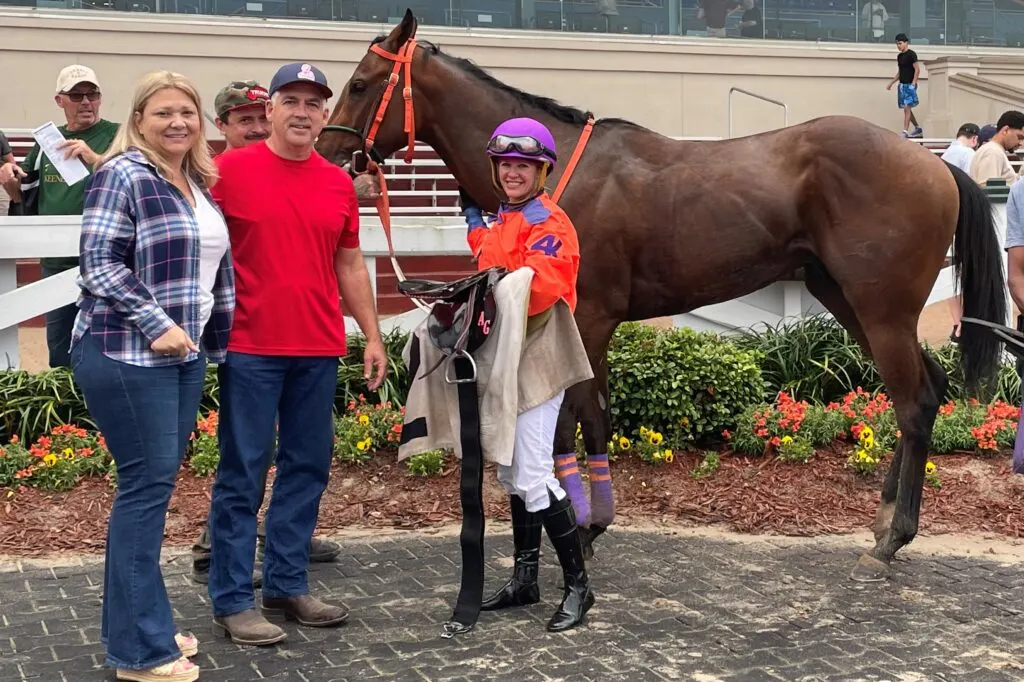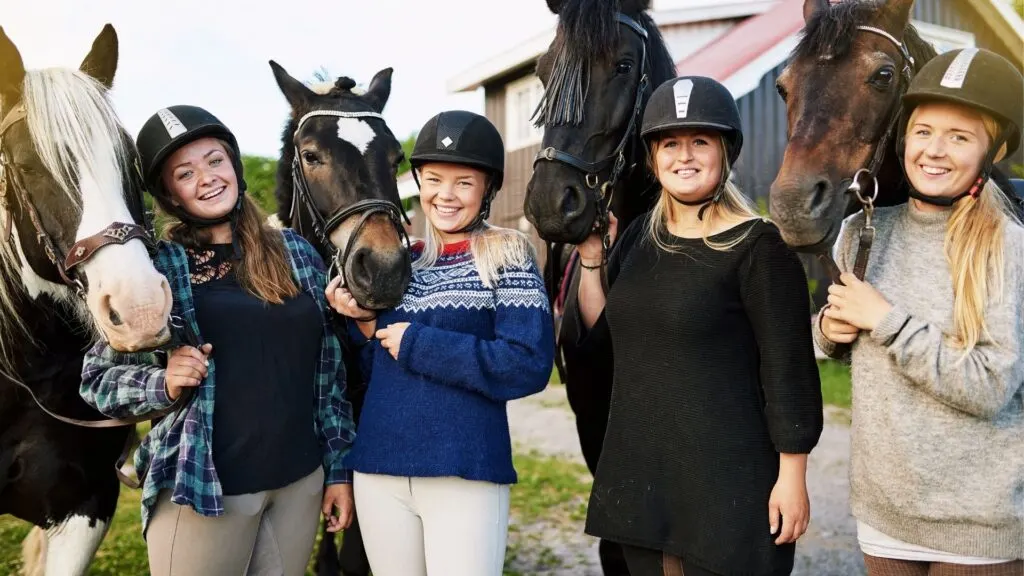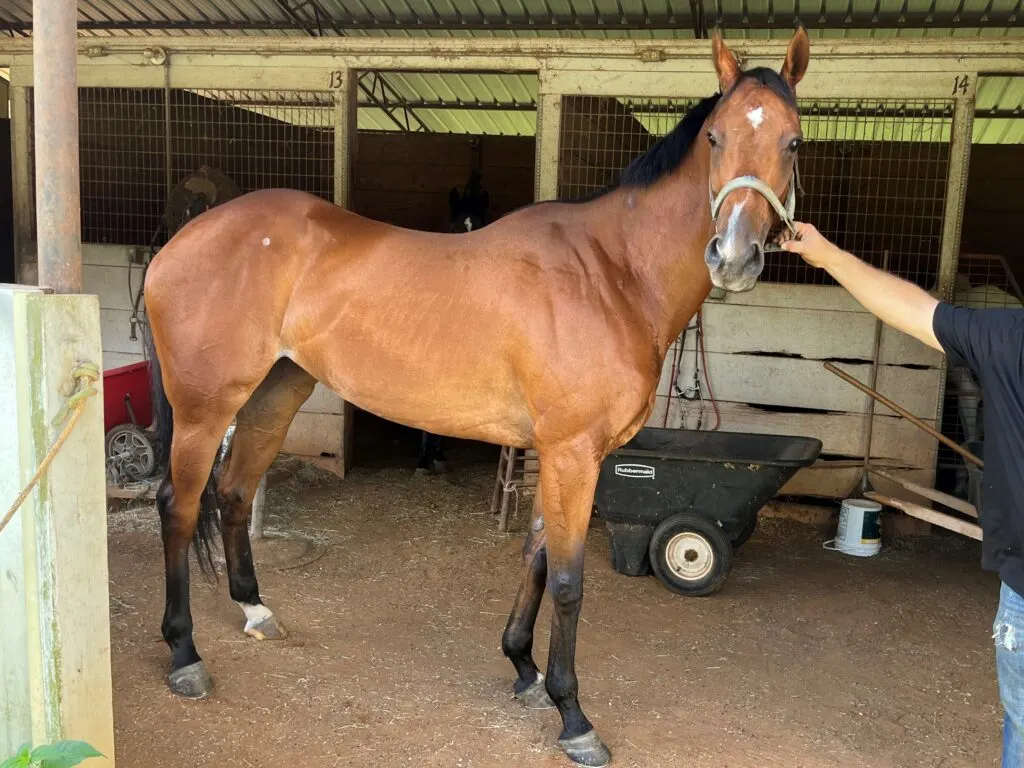Last updated: May 3, 2023
When my grandson asked me what happens to our racehorses after they finish their racing careers, I realized that not everyone might know about their post-racing journey. As a racehorse owner, I’ve witnessed their transition from the racetrack to various fulfilling second careers.
Post-retirement, racehorses frequently flourish in diverse careers like dressage, show jumping, polo, therapy work, recreational riding, or equine-assisted learning. You can identify a new path by assessing each horse’s distinctive qualities, guaranteeing a fulfilling life beyond the racetrack for these exceptional animals.
In this blog post, we’ll explore the world of Off-the-Track Thoroughbreds (OTTBs) and their exciting new careers. We’ll discuss their challenges, the popular second career options available to them, and the factors contributing to their success in these new roles. Join me as we uncover the inspiring stories of retired racehorses beyond the racetrack.
Understanding the Transition
Retired racehorses often face challenges adapting to a new life away from the racetrack. For example, racehorses are typically used to a high-energy diet and might require a gradual change to a more balanced diet suitable for their new lifestyle. Additionally, some horses may have been on medications during their racing days, so it’s essential to consult with a veterinarian to ensure a safe transition.

Another challenge retired racehorses face is adjusting to a new routine, as they often spend long hours cooped up in a stall while racing. It’s crucial to gradually introduce them to more time outdoors, allowing them to adapt to their new environment and learn how to socialize with other horses.
The rehabilitation and retraining process plays a significant role in helping retired racehorses adapt to their new careers. This process involves building trust between the horse and its new owner or trainer. With time, love, and patience, the horse can learn new skills and thrive in its second career, whether jumping, dressage, or just going on trail rides.
Several factors should be considered when choosing a new career for a retired racehorse. These include the horse’s personality, physical condition, and experience level of the potential owner or trainer. Assessing these factors can help ensure a successful transition and a fulfilling new chapter for the horse and its new caretaker.
Popular Second Careers for Retired Racehorses
If you’re considering adopting a retired racehorse, you might wonder what kind of jobs these incredible animals can do. There are many popular second careers for retired racehorses where they can showcase their talents and bring joy to their new owners. Let’s explore some of these exciting options.
A. Show Jumping
Show jumping is a competitive sport that requires horse and rider to work in harmony to clear a series of obstacles within a set time. Success in this discipline depends on the horse’s natural athleticism, strong work ethic, and agility.
Retired racehorses, known as Off-the-Track Thoroughbreds (OTTBs), possess these qualities, making them excellent candidates for show jumping. They can develop the necessary jumping technique, balance, and coordination with proper training.
One inspiring example is “Neville Bardos,” an OTTB purchased for just $850 after his racing career ended. Through dedication and training, Neville became a top show jumping competitor and was even named Horse of the Year in the discipline. His story highlights the incredible adaptability and talent of retired racehorses when given the opportunity of a new career.

B. Dressage
Dressage is an elegant equestrian sport emphasizing harmony, precision, and fluid movements between horse and rider. To succeed in this discipline, a horse needs to be well-balanced, supple, and responsive to subtle cues from the rider. Off-the-Track Thoroughbreds (OTTBs) have the innate athleticism and sensitivity that can develop through proper training to excel in dressage.
A prime example of an OTTB’s success in dressage is Keen. After retiring from racing, Keen was trained by Hilda Gurney, a renowned dressage rider and trainer. Keen went on to represent the United States in international competitions, showcasing the potential of retired racehorses in the dressage world.
C. Eventing
Eventing is a challenging equestrian sport that combines dressage, cross-country, and show jumping in a single competition. It tests the horse’s versatility, endurance, and athleticism, as well as the strong bond between horse and rider. Off the track, Thoroughbreds often possess the necessary stamina, agility, and courage to excel in eventing with proper training and conditioning.
One remarkable example of an OTTB’s success in eventing is “Courageous Comet.” After retiring from racing, this former racehorse found a new career with Olympic rider Becky Holder. Together, they competed at the highest levels of eventing, including the prestigious Rolex Kentucky Three-Day Event and the World Equestrian Games.
D. Polo
Polo is a fast-paced, exhilarating team sport where riders and their horses work together to score goals by hitting a small ball with a mallet. To succeed in this discipline, a horse needs to be agile, quick, and able to make tight turns. Retired racehorses, or Off-the-Track Thoroughbreds (OTTBs), often have the speed, athleticism, and courage required for polo, making them excellent candidates with proper training and conditioning.
Many retired racehorses have found new careers in polo, utilizing their speed, athleticism, and courage to excel in the sport. With the proper training and opportunities, these former racers can successfully transition to the polo field, demonstrating their adaptability and talent in a wide range of disciplines.

E. Therapy and Service Animals
Therapy and service animals are crucial in providing comfort, support, and assistance to individuals with physical, emotional, or mental health challenges. Some Off-the-Track Thoroughbreds (OTTBs) can make excellent therapy and service animals with proper training. These horses can learn to respond to specific needs, providing valuable companionship and assistance to those who require their help.
Organizations like the Professional Association of Therapeutic Horsemanship International (PATH Intl.) and equine-assisted therapy programs worldwide often work with OTTBs to provide therapy services.
These programs use the unique qualities of horses, including their empathy, patience, and intuition, to facilitate emotional healing, physical rehabilitation, and personal growth for people of all ages and backgrounds. The adaptability and resilience of retired racehorses make them invaluable partners in these life-changing programs.
F. Recreational Riding
Recreational riding is a popular way to enjoy spending time with horses while experiencing the great outdoors. Retired racehorses can become wonderful recreational riding companions due to their adaptability, intelligence, and willingness to learn new skills.
With proper retraining and conditioning, these horses can transition from the high-speed world of racing to a more leisurely pace, providing a steady and enjoyable ride for their new owners. The natural athleticism, endurance, and smooth gaits of OTTBs make them well-suited for various types of recreational riding, such as trail riding, pleasure riding, and even low-level competitive events.
Their ability to bond with humans and respond to their rider’s cues ensures a strong partnership and an enjoyable experience for both horse and rider. The journey of an OTTB from the racetrack to a loving home as a recreational riding companion highlights these remarkable animals’ incredible versatility and potential.
Check out this YouTube video about retraining retired racehorses.
G. Equine-Assisted Learning Programs
Equine-Assisted Learning (EAL) programs use horses as partners to teach valuable life skills, promote personal growth, and enhance emotional well-being. These programs rely on the unique ability of horses to mirror human emotions and respond to non-verbal cues, making them effective teachers in areas like communication, problem-solving, and teamwork.
OTTBs, with their background in the high-pressure world of racing, can offer valuable insights and lessons for participants in EAL programs. Their adaptability and resilience make them ideal candidates for these transformative experiences.
Organizations like the Equine Experiential Education Association (E3A) and various equine therapy centers around the world often incorporate OTTBs into their programs, where these retired athletes continue to positively impact the lives of those they encounter.

Success Factors for OTTBs in New Careers
To ensure a successful transition for retired racehorses, it’s essential to first identify the most suitable career path for each horse. Factors such as temperament, physical condition, and natural abilities should be considered to find the best match, leading to a fulfilling second career.
Providing retired racehorses with proper training and support is essential for their success in new careers. This involves collaborating with experienced trainers and professionals who understand the unique needs of OTTBs and can help them develop the necessary skills for their chosen discipline.
The transition to a new career can be challenging for both the horse and its new owner or trainer. Patience and dedication are crucial in helping the horse adjust to its new life and learn new skills. Retired racehorses can thrive and excel in their second careers by investing time and effort into building trust and understanding.
Feeding Tips for Ex-Racehorses
Feeding an ex-racehorse requires a balanced diet that meets its nutritional needs as it transitions to a new lifestyle. Consider these guidelines:
- Gradually reduce high-energy feeds: Ex-racehorses are often fed high-energy diets for performance. Slowly decrease these feeds while introducing forage-based diets to avoid sudden changes in the digestive system.
- High-quality forage: Provide hay or pasture grazing, which should make up most of the diet. Ensure the forage is of good quality to meet the horse’s fiber and nutrient requirements.
- Balanced concentrate feed: Choose a concentrate feed formulated for the horse’s new activity level and adjust the amount according to its body condition and workload.
- Monitor weight and condition: Regularly assess the horse’s body condition and adjust the diet as needed.
- Supplement as needed: If your horse requires additional nutrients, consider supplements such as vitamins, minerals, or joint support.
- Fresh water: Always provide clean, fresh water.
Consult with a veterinarian or equine nutritionist to create a tailored feeding plan for your ex-racehorse based on its age, activity level, and health status.
Conclusion
Retired racehorses have immense potential for successful second careers beyond the racetrack. With options such as show jumping, dressage, eventing, and even therapy work, these versatile and talented animals can find a new purpose and enrich the lives of those around them.
By finding the right match between horse and career, providing proper training and support, and demonstrating patience and dedication, new owners and trainers can help Off-the-Track Thoroughbreds thrive in their new endeavors.
Embracing the journey of retired racehorses not only gives them a well-deserved opportunity for a fulfilling life but also showcases these amazing animals’ incredible adaptability and resilience.
FAQs
How do I find a retired racehorse?
To find a retired racehorse, visit reputable adoption organizations and racetrack placement programs, or connect with trainers and owners directly. Online listings and social media can also help you discover available OTTBs.
What is the Thoroughbred Incentive Program?
The Thoroughbred Incentive Program (TIP) is an initiative by The Jockey Club to encourage the retraining and adoption of retired racehorses. TIP offers awards, prize money, and recognition in various equestrian disciplines for registered thoroughbreds, promoting their versatility and value as they transition to new careers beyond the racetrack.
Meet Miles Henry
An avid equestrian and seasoned racehorse owner, Miles Henry brings his extensive experience to the equine world, proudly associating with the AQHA, The Jockey Club, and various other equine organizations. Beyond the racetrack, Miles is an accomplished author, having published various books about horses, and is a recognized authority in the field, with his work cited in multiple publications.
🔗 Connect with Miles:
Twitter
Facebook
YouTube: Check out race highlights, horse care tips, and more!

